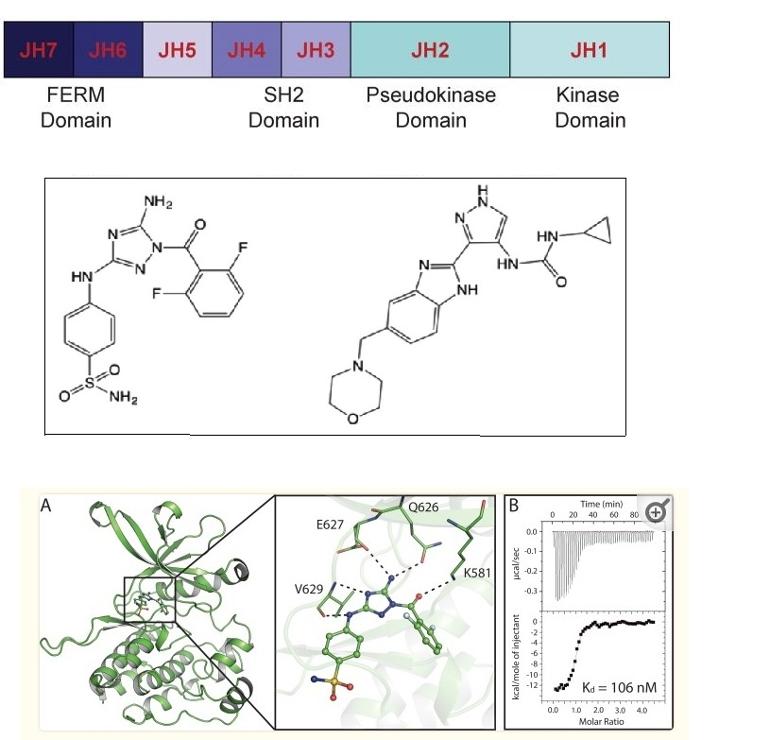This Incyte drug is in ph1 for MF as well posted previously. As I've noted, a key advance is the ability to find and target something specific to the Jak2 mutation. This has not been possible before. Curious I checked out an early study (2017) and another (2009)
This is quite technical for any of us but this is my effort to figure some. But I've tried to make some sense of it and it gives some "Incyte" into the guys behind the curtain that are helping us while hoping to make money.
There are too many J's in the names, this requires extra attention.
--
Info here is from:
ncbi.nlm.nih.gov/pmc/articl...
and
ncbi.nlm.nih.gov/pmc/articl...
There are four Jaks: Jak1, Jak2, Jak3, and Tyk2(Jak4). Each of these has domains JH1 to JH7, see image here (blueish boxes). We know about Jak2 and its v617f mutation, which occurs on the JH2 domain of Jak2 as noted in this report (some of the other Jaks are targets for new autoimmune drugs)
"The JAK pseudokinase domain (JH2) is autoinhibitory of the protein’s kinase domain (JH1) activity, likely by direct interaction with the JH1 domain." This means in non Jak2 mutated people JH2 keeps a lid on JH1. But "mutations within the JAK JH2 domain release autoinhibition" So in us Jak2 MPN pts, JH2 can't do its job and JH1 is not properly controlled.
"Recent evidence shows that displacing ATP from the JAK2 JH2 domain alters the hyperactivation state of the oncogenic JAK2 V617F protein while sparing the wild type JAK2 protein". This is the big advance, finding where and what to modify, see color detail box in the image Fig. A. ATP is a high school biology thing about storing energy that is everywhere in the body.
So "we sought to identify small molecules that bound selectively to the JH2 domain of the JAK2 protein" and keep out the ATP. "The JH2 protein was screened against...kinase inhibitor libraries." They found that the two molecules in the chemistry looking image worked best.
The color image: "Shown is the overall JH2 domain structure and magnified view of the ATP-binding pocket". Hit this newly discovered pocket, keep out the ATP and our mutation is deactivated. The Jak2's with wild type (non-mutated) JH2 are unaffected.
--
They did not fully solve best selectivity for JH2 (where the mutation resides) over JH1. But this more recent report (2023) covers the improvements since the 2017 report above. Likely much of the advance was from within Incyte.
--
ashpublications.org/blood/a...
" Ruxolitinib acts by directly inhibiting activity of the kinase domain (JH1) of JAK2". We now know from above that we really want to inhibit JH1 indirectly, via JH2, and in a very specific way.
But there is one inaccuracy in this report: " they (current Jaki-s) do not address JAK2V617F allelic burden or achieve molecular remission of disease." While Rux in theory should not have this effect we know from this forum and recent reports that Rux can and does exactly that for many. So the new agent should really knock it out.
"Using structure- and function-guided molecular design, INCB160058 was designed to bind with picomolar (extraordinary small amounts) affinity to the JH2 domain of JAK2V617F at the canonical ATP-binding site, with high specificity (>2500-fold) relative to binding at the active kinase domain (JH1) targeted by currently approved JAK inhibitors". INCB160058 works with the tiniest bit of the drug to occupy the JK2 site, keep out the ATP, and deactivate the mutation. And it leaves JH1 alone to function normally. Rux by contrast targets the JH1 presumably of both Jak1 and Jak2 which would expect to see side effects.
Conclusion: " INCB160058,(is) a high-affinity pseudokinase (JH2) binding inhibitor of JAK2V617F" From the above, this tech sentence can make sense, '0058 hits the sweet spot that was recently discovered. "Extended treatment with INCB160058 at low therapeutic doses results in the specific elimination of mutant JAK2V617F-harboring cells in mouse models and human cancer cells with minimal impact on WT counterparts" This adds a so far unexplained element, the cells with mutated JH2 aren't just deactivated, but are eliminated.
--
This is now in phase 1 trial. If you have lost response to Rux with MF you may qualify. But trial sites are few.
clinicaltrials.gov/study/NC...
--
From what I've seen, IFN is not understood anywhere near this level, but it's known empirically to work. If the experts could get there, maybe they could make an IFN without the FDA black box.
